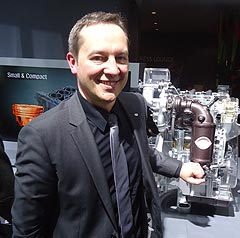News - KiaGeneva show: Car-makers have particulate problemPicanto: Kia will offer a 998cc three-cylinder petrol and dual-fuel petrol-LPG engine in its next-gen city car. Soot solution sought for direct-injection turbos ahead of Euro 68 Mar 2011 NEW-GENERATION direct-injection turbo-petrol engines might be more fuel efficient, but they are causing a headache for engineers trying to achieve looming Euro 6 emissions regulations because of a problem that traditionally has been associated with diesels: particulates. The soot that forced diesel engine designers to resort to hi-tech particulate filters on oil-burning engines also comes under scrutiny on direct-injection petrol engines under Euro 5 and 6 regulations. The problem arises when liquid petrol droplets form a film on surfaces in the combustion chamber of highly charged engines, leading to unburned particulates. According to Hyundai-Kia Europe powertrain engineering design and testing manager Joachim Hahn, car-makers would prefer not to have to fit expensive particulate filters on to petrol engine exhaust systems to achieve the tighter Euro 6 limits when they come in on all new models introduced in Europe from September 1, 2014. He said at the Geneva motor show that Hyundai-Kia engineers were looking for other solutions to the issue which arises when petrol DI engines are highly charged.  Left: Hyundai-Kia Europe powertrain engineering design and testing manager Joachim Hahn. Left: Hyundai-Kia Europe powertrain engineering design and testing manager Joachim Hahn.“In the European market where the Euro 6 is coming up, one issue that come up is particulate emissions, which was never important for gasoline (engines),” he said. “It is not just the mass of the particles but also the number of particles. “That was always not an issue for gasoline, but now, GDI (gasoline direct injection) turbo engines have to keep an eye on their internal combustion efficiency, especially regarding particle emissions. “Now, what all car manufacturers want to avoid is that gasoline engines might eventually need some kind of filter like the diesels. “We already know that beside the technical solution, there is a market behind our product. “We had the situation a couple of years ago in Europe where there have been technical solutions for internal combustion optimisation for diesels engines to Euro 4 for particulates, but the mood changed – one competitor introduced a particulate filter and then all the others were more or less forced to follow as a particulate filter became a sign of a clean engine. “Currently, we see ourselves in the same situation.” One such engine from the Hyundai-Kia stable that might be affected by such decisions is a new 1.2-litre direct-injection turbo four-cylinder Kappa engine from Hyundai-Kia. Mr Hahn revealed that his company had prepared the engine for roll-out on unspecified future models, providing the fuel consumption of a small engine and the power of a larger powerplant. “This engine can easily replace a naturally aspirated engine of 1.6 (litres) or even higher – 1.8,” he said. “You can assume that this 1.2 TDGI is a really good powertrain for C (small) segment, for example.” This would indicate that the new engine might find its way into Kia’s next generation Cerato, which is currently under development for launch in the next two years, the Kia Soul, which is based on the same platform, and the Hyundai Elantra. Mr Hahn also revealed that Hyundai-Kia engineers had looked at developing a twin-cylinder engine for one-litre or sub-one-litre applications, and despite promising fuel efficiency gains, had opted for a three-cylinder design for better noise, vibration and harshness (NVH) performance. Kia will offer a 998cc three-cylinder petrol and dual-fuel petrol-LPG engine in the new Picanto city car, which, at this stage, has not yet been locked in for Australian sale. Kia and Hyundai buyers can also expect wider application of idle-stop fuel saving technology. Mr Hahn said fuel savings from the system in urban driving had proved to be greater than the official test cycle might suggest. He said this was because the system did not switch on until the engine had warmed up, yet the official fuel-test cycle started with a cold engine.  Read more |
Click to shareMotor industry news |
















Facebook Twitter Instagram